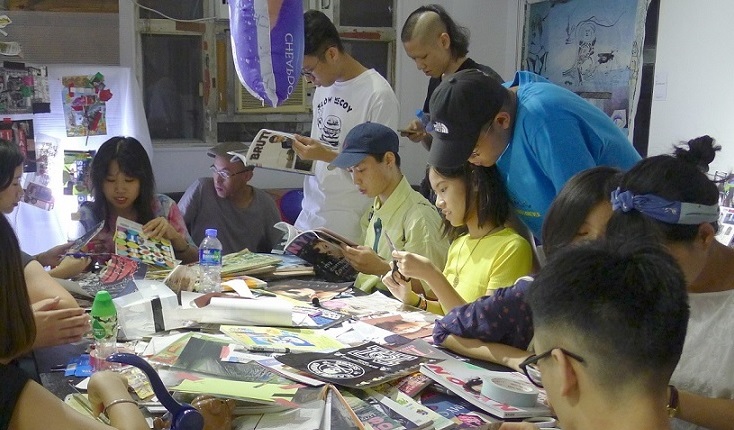藝評
創意對話 | Creative Conversations
約翰百德 (John BATTEN)
at 9:03am on 26th September 2018

圖片說明 Caption:
在8月25日在Cheapdoy美勞展中舉行的拼貼派對Collage party during Cheapdoy’s exhibition opening, 25 August 2018
攝影:約翰百德 Photograph: John Batten
(Please scroll down for English version)
Cheapdoy是一群年輕設計師,他們對平面設計、音樂、視覺藝術和協作創意活動等有著兼收並蓄的聯乘興趣。他們近日在網絡電台Hong Kong Community Radio (簡稱 HKCR)位於灣仔的錄音室,舉行了一場為期四天的展覽,展出精心設計的T恤、短片播放、拼貼藝術作品和裝置。HKCR每星期都舉辦讓聽眾看得見的DJ環節,在網上串流播放視頻,稍後再在網上存檔。
被 Cheapdoy完全佔用後,HKCR的錄音室變成了臨時的藝術工作室。房內擺放了一張長桌,上面堆疊著五花八門的報章雜誌。圍著長桌的,是展覽開幕日的訪客,全部都是十多二十歲的年輕人,他們埋頭苦幹,從報章雜誌上剪下圖案照片,再往紙上拼貼成新的設計。這些拼貼畫作中,有些稍後在房間周圍張貼。其他人則在認真地設計可供閱讀的拼貼書冊。在另一個房間, DJ在混音,演奏長篇即興實驗雜音。
Cheapdoy這個「美勞展」拼貼派對是行動式的創意展現,在一片歡樂對話的氣氛中有著嚴肅的活動底流;藝術、設計與音樂的知識在房間內自由傳送。由博物館等正規藝術組織主辦的藝術活動,通常都以「觀眾投入」和「社區參與」為目標。以M+為例,便有在特製貨車上裝設的「M+進行」巡迴展覽, 到訪學校和邀請不同藝術家帶領同學進行「互動」和教育活動。然而,Cheapdoy的拼貼派對,卻是即興自發的,也不以領頭人為焦點。相反,它是一個漫不經心地互動和向彼此學習的機會。
年輕人可以被狠批。Cheapdoy的成員都是「千禧」世代。有關千禧世代態度的研究總是雞毛蒜皮,但傳媒和一般人的印象,都籠統地把千禧世代描繪為事事想當然,處處展現自我沈迷、自戀傾向的一代。他們也被視為俗套,是在溫室中長大的孩子。優點方面,則被認為富自信,追求成績和以團體為先。在職場上,千禧世代希望擁有較佳的工作生活平衡,而工作上的滿足感,通常由上司與下屬間的溝通有多開誠布公來釐定。有趣的是,僱主給千禧世代的標籤卻是不利工作,而且難以督導。
我必需說,以上種種在我差不多年紀的時候,並沒有太大分別;我們年輕時同樣被父母輩這樣批評。
1970年代的音樂之夜,會是我和友人圍著「身歷聲」唱機,一同聽著新唱片。音樂播放之間,當要把唱片反轉,播放另一面時,我們會討論剛剛聽過的音樂,去多泡一杯茶,再熱烈討論政治和生活;眾人會傳閱漫畫/繪本/圖冊。我們那時都抽太多煙。在那樣的夜裡,我第一次聽到朋友們兼收並蓄的口味,例如:Sonny Terry & Brownie McGhee、Brian Eno、The Sex Pistols、King Crimson和Van der Graaf Generator。我是經他們首次讀到Raoul Dahl的陰森短篇故事,例如《Kiss Kiss》系列中的經典故事。Edward Gorey的插畫和故事(精彩的超現實作品《The Object Lesson》和《The Doubtful Guest》)。我們欣賞Arthur Rackham藝術中的美麗夢幻畫作、托爾金的《哈比人》,也一同為約翰.連儂的《A Spaniard in the Works 》捧腹大笑。
沒有,現在和那時候的分別沒有很大。
就如Van der Graaf Generator 樂隊的Peter Hammill 在這樣的晚上唱著:「……充滿睿智的對話、說說笑、抽抽煙和連珠妙語,所有午夜的對話,所有友誼,所有用字和所有旅程……」
www.facebook.com/cheapdoy.hk
www.facebook.com/hkcrlive
原文刊於《明報周刊》,2018年9月13日
Creative Conversations
by John Batten
Cheapdoy is a group of young designers who have an eclectic cross-over interest in graphic design, music, visual art and collaborative creative activities. Their recent 4-day exhibition featured designed T-shirts, video projections, collaged art work and installations inside Hong Kong Community Radio’s (HKCR) Wan Chai studio. Every week, this community radio station organises DJ sessions that can be seen by an audience, streamed live online, then later archived.
Completely taken-over by Cheapdoy, HKCR’s studio became a temporary working artist studio dominated by a long table stacked with glossy magazines and newspapers. Around it, the exhibition’s opening day visitors, all aged in their late-teens and twenties, sat studiously cutting from magazines and pasting their collaged designs onto paper. Some of these collages were later pinned-up around the room; others were elaborately designed books of collages available to be read. In a separate room, DJs mixed music and performed long improvisations of experimental noise.
Cheapdoy’s ‘collage party’ was creativity in action, in an atmosphere of convivial conversations and a serious undercurrent of activity; knowledge about art, design and music freely passed around the room. ‘Audience engagement’ and ‘community participation’ is often an aim for art events organized by official art institutions, such as museums. M+, for example, has a travelling exhibition, Mobile M+, set-up on a special truck that visits schools and employs different artists to lead ‘interactive’ and educational activities with students. Cheapdoy’s collage party, however, was spontaneous and without a leader as a focus, instead, it was an opportunity for nonchalant interaction and learning from each other.
Young people can be harshly judged. The members of Cheapdoy are of the ‘millennial’ generation. Research done on the attitudes of millennials is nuanced, but the press and common perception gives a broad-brushed portrayal of millennials having a sense of entitlement and displaying self-obsessed, narcissistic traits. They are also seen to be conventional and sheltered, but are also acknowledged to be confident, achievers and team-orientated. In the work-place, millennials want a better work-life balance; and job satisfaction is often judged by how open communication is between supervisors and staff. Anecdotally, employers label millennials as work adverse and difficult to supervise.
I must say, all this doesn’t sound much different from when I was a similar age; we were equally judged by our parent’s generation.
A night of music in the 1970s would have been me and friends sitting around a stereo listening to new records. During the gaps when one side of a record needed to be turned to the other side, we discussed the music just heard, made another cup of tea, had vigorous discussions about politics and life; and passed comic/graphic/illustrated books between each other. We all smoked too much. On nights like this, I first heard the eclectic taste of my friends, such music as: Sonny Terry & Brownie McGhee, Brian Eno, The Sex Pistols, King Crimson and Van der Graaf Generator. I first read Roald Dahl’s macabre short stories, such classics as in his collection Kiss Kiss. The drawings and stories of Edward Gorey (the fabulously surreal The Object Lesson and The Doubtful Guest). We appreciated the art of Arthur Rackham’s beautiful fantasy paintings, Tolkien’s The Hobbit and laughed through John Lennon’s A Spaniard in the Works.
No, it is not much different now from then.
As Peter Hammill of Van der Graaf Generator sang on nights like this, there was: “…the clever talk, the joking, the smoking and the quips, all the midnight conversations, all the friendship, all the words and all the trips…”
www.facebook.com/cheapdoy.hk
www.facebook.com/hkcrlive
This article was originally published in Ming Pao Weekly on 13 September 2018.
|
|
|
|
|
|
